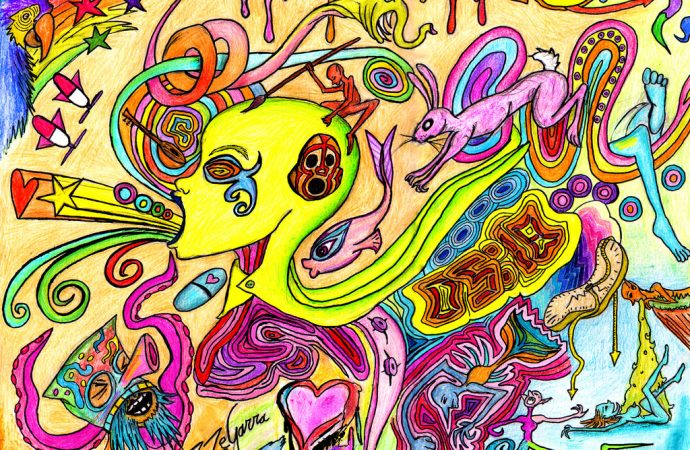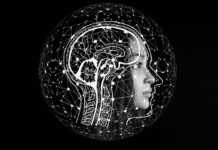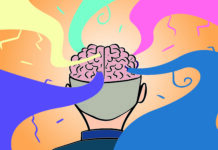LSD (lysergic acid diethylamide) is a psychedelic drug that was synthesized in 1938 but became famous much later, in the hippie culture of the ‘60s, for its ability to elicit hallucinations and alter consciousness. Users of LSD called the experience produced by the drug an “acid trip”, and many described it as enhancing their mental faculties. However, others reported having “bad trips”, characterized by extreme fear, panic attacks, and intense anxiety. According to some reports, LSD might increase the risk of mental disorders in the long term. Studying the benefits and drawbacks of psychedelic drugs might therefore help researchers to understand the complexity of the human brain.
How does LSD induce hallucinations?
In an article published recently in PNAS, Carhart-Harris from the Imperial College in London, and colleagues examined the brains of 20 healthy volunteers, who agreed to lie down, close their eyes and take LSD. Volunteers who received a placebo instead of LSD were used as controls. Using functional Magnetic Resonance Imaging (fMRI) and magnetoencephalography (MEG), researchers were able to study brain activity levels (by measuring changes in blood flow and oxygen consumption), and brain electric activity, respectively.
Volunteers were also asked to describe their ‘trips’ by answering a questionnaire. They were asked, for instance, to evaluate how vivid their imagination was after taking the drug, if they felt unusual body sensations, if they saw geometric patterns, if they felt afraid or if they lost the sense of self thus experiencing the phenomenon of ‘ego dissolution’.
In volunteers that experienced hallucinations, LSD was shown to decrease alpha waves power and to stimulate the visual cortex area. By comparing these results to those of control subjects, researchers were able to conclude that the effects of LSD in the visual cortex are identical to the effects of light hitting the retina. In addition, LSD decreased alpha waves power, which might also explain hallucinations since these waves are involved in the creation of realistic images by filtering out irrelevant information.

in subjects under LSD (grey: low activity; yellow: high activity)
How does LSD alter consciousness?
Besides its effects on the visual cortex, LSD also affected the connection between brain areas associated with memory, recognition of environmental scenes, and perception. This is associated with the effects of LSD on consciousness, especially with the intensity of ‘altered-meaning’ (giving special and unusual meaning to things that normally are perceived as unimportant) and ‘ego-dissolution’ (losing the sense of the self). ‘Ego-dissolution’ was also accompanied by a decrease in the power of different brain waves, suggesting that regular rhythms in those regions may be crucial for the maintenance of the sense of self.
Researchers also found a decrease in the integrity of the so-called Default-Mode Network (DMN). The DMN is a set of brain regions that is more active when a person is at rest rather than involved in a cognitive task. The DMN is considered a main orchestrator of high-level cognitive processes, including the sense of self, self-reflection and introspection. Thus, its functional disorganization induced by LSD very likely disrupts cognitive activities and contributes to the alteration of consciousness.
How can psychedelic drugs help understanding psychosis?
There are similarities between the state of altered consciousness induced by psychedelic drugs and some aspects of psychosis. For instance, some mental disorders, similarly to LSD, cause the loss of the sense of self and a distorted interpretation of reality. In addition, the reduced connectivity in certain brain areas also happens in patients with psychosis. Therefore, understanding the influence of LSD on these brain areas associated with the sense of ego and critical thinking can be an important step to grasp the psychology of psychosis.
Learn more about psychosis in Pieter’s latest article.
Can LSD help treating psychosis?
Another important issue debated today is whether LSD and other psychedelic drugs have therapeutic potential. As mentioned above, LSD disrupts certain brain cortex circuits and causes disorder in the transmission of electrical impulses (“disordered” DMN activity). In many cases, psychiatric patients adopt automated and rigid behaviors, which suggest that their brain has established fixed circuits that prevent normal brain activity. By creating disorder in the cortical activity, LSD might help break down these stiff circuits and normalize the brain electrical activity in psychotic patients.
Studying the mechanisms of action of LSD in the brain is certainly important to understand human consciousness and perception of reality. Similar studies will further our knowledge about brain physiology and pathology, and raise new ideas for novel therapies to treat mental disorders. In particular, the idea of LSD as a treatment for psychosis deserves investigation and should boost interest in research on psychedelic drugs.
References
Carhart-Harris, R., Muthukumaraswamy, S., Roseman, L., Kaelen, M., Droog, W., Murphy, K., Tagliazucchi, E., Schenberg, E., Nest, T., Orban, C., Leech, R., Williams, L., Williams, T., Bolstridge, M., Sessa, B., McGonigle, J., Sereno, M., Nichols, D., Hellyer, P., Hobden, P., Evans, J., Singh, K., Wise, R., Curran, H., Feilding, A., & Nutt, D. (2016). Neural correlates of the LSD experience revealed by multimodal neuroimaging Proceedings of the National Academy of Sciences, 113 (17), 4853-4858 DOI: 10.1073/pnas.1518377113
Carhart-Harris, R., Leech, R., Hellyer, P., Shanahan, M., Feilding, A., Tagliazucchi, E., Chialvo, D., & Nutt, D. (2014). The entropic brain: a theory of conscious states informed by neuroimaging research with psychedelic drugs Frontiers in Human Neuroscience, 8 DOI: 10.3389/fnhum.2014.00020
Hagmann, P., Cammoun, L., Gigandet, X., Meuli, R., Honey, C., Wedeen, V., & Sporns, O. (2008). Mapping the Structural Core of Human Cerebral Cortex PLoS Biology, 6 (7) DOI: 10.1371/journal.pbio.0060159





